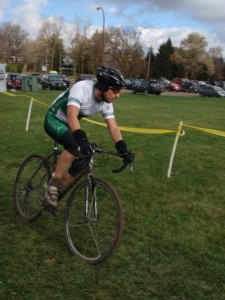The “Dos”

Animals (and therefore humans) thermoregulate in hot or cold conditions by making either physiological or behavioral changes. The first blog about racing cyclocross in the cold dealt a lot with the physiological processes and concepts that assisted thermoregulation. This blog will deal mostly with the behavioral things racers can do to help them thermoregulate. In nature, animals (and humans) use behaviors such as moving in or out of sunlight or the wind, or increasing their activity to help with thermoregulation. Cross racers don’t have the ability to move themselves into better thermoregulating positions unless the course directs them there (unless of course you count curling your finger tips around the bar to keep them out of the wind) and they are already exercising at max so increasing activity is not really an option either. This leaves cross racers with one last behavior that they have control over: how they dress.
What clothes a racer should wear during a cross race deals a lot with the factors that were covered in the basics of thermoregulation blog (anthropometric measurements, physiological responses, environmental conditions, etc). It really comes down to the fact that there is enough variance between individuals that each person will most likely have to find what kind of clothing works for them for each weather condition. This isn’t good news for someone who doesn’t race in the cold often, or ever (but on the bright side, at least you don’t really have to worry about acclimating to the climate in order to perform well). For people who do have a chance to race and ride in the cold it’s a good idea to record what you wear and the weather conditions you competed in into your training logs so you have a reference of what works and doesn’t work.
By now it should be understood that, in terms of thermoregulation and racing bikes in the cold, it’s all about maintaining a body temperature for optimal performance (not to high & not too low), while at the same time protecting extremities. In cold conditions it is completely possible to have your core temperature at an optimal level for performance, but still be at risk of extremities getting frostbitten. These parts include: ears, fingers, toes, noses, man parts, and in extreme cases chins and cheekbones; but the order of importance for protecting these parts from the cold often depends on the individual. It is also a good idea to cover the knee and protect it from the cold, even though it isn’t necessarily considered an “extremity”. This is because of a multitude of factors: it is an uber-important joint for cycling, it has little fat insulating it, it has little vascular tissue surrounding it, connective tissues in joints move better when they are warm, and it is exposed to wind and air movement from the forward motion of the bike which causes it to cool quickly. A felt lined knee warmer, tight, or knicker is the way to go for knee protection… not embrocation, as discussed earlier.
Other clothing tips involve surface to volume ratios. The head and arms have a lot of surface for the amount of volume they have and also have a lot of circulation running through them. They are great places to lose heat and should be the first places to be covered when trying to conserve heat (i.e. the warm-up). Due to the fact that wearing a helmet when racing cyclocross is compulsory, changing headgear during competition becomes pretty much impossible. This leaves the arms as the best part on the body to cover or uncover for thermoregulation purposes while racing. Which is why, in my opinion, arm warmers are one of racers’ best friends. If you are overdressed, arm warmers can be quickly peeled down to allow for cooling while racing.
A non-thermoregulating “do” when racing cyclocross in the cold is to be aware of cold induced branchospasms. If you have a history of allergies or asthma you may be more susceptible to this. If you are, a trip to your doctor or a specialist may be in order. There are drugs that can alleviate these constrictions, but beware of the use of these drugs and doping restrictions. It is the responsibility of the racer to know what they put in their body.
Tipton, C. M., Sawka, M. N., Tate, C. A., Terjung, R. L. (Eds.). (2006). ACSM’s Advanced Exercise Physiology. Philidelphia, PA: Lippincott Williams & Wilkins.
